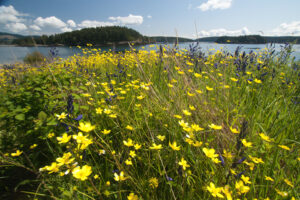
Dear EarthTalk: What’s the background on the “No Mow May” movement?
– J.D., via email

Lawns cover some 40 million acres—or two percent—of land in the United States, making them the single largest irrigated crop we grow. We mow, rake, fertilize, weed, chemically treat and water them—sucking up time, money and other resources. And in spite of all that they provide little if any benefit to wildlife. In fact, they likely do more harm than good. Indeed, grass-only lawns lack floral resources and nesting sites for bees and other pollinators, and serve up a cocktail of toxic pesticides.
Addressing these issues is where the No Mow May campaign comes in, encouraging people to refrain from mowing their lawns during the month of May. The idea is to let wildflowers and other plants grow, providing important habitat for bees, butterflies, and other pollinators. The campaign was started in the United Kingdom by the environmental charity Plantlife in 2018. Since then, it has gained popularity in other countries, including the U.S. and Canada. The goal of No Mow May is to raise awareness about the importance of biodiversity and to encourage people to take action to support pollinators.
Many people mow their lawns frequently, often using gas-powered mowers that emit carbon dioxide and other pollutants. This can be harmful to the environment, as well as to human health. Mowing also destroys wildflowers and other plants that provide food and shelter for pollinators. By refraining from mowing their lawns during the month of May, people can help to create a habitat for pollinators. This can include bees, butterflies, moths and other insects, as well as birds and small mammals that feed on them. These creatures play an important role in pollinating crops, which is essential for the production of many types of food.
No Mow May is not only good for the environment, but it can also be good for your lawn. Allowing wildflowers and other plants to grow can help to improve the health of your soil, reduce erosion, and provide a natural fertilizer. This can lead to a healthier lawn that requires less maintenance over time.
If you decide to participate in No Mow May, there are a few things you can do to ensure that your lawn stays healthy and safe. First, make sure that your lawn is free of any hazards, such as large rocks or debris, that could pose a risk to people or pets. You should also check for any weeds or invasive species that could harm native plants.
During the month of May, you can still perform basic lawn maintenance, such as watering and weeding. You can also mow any areas that are high traffic or that pose a safety risk. However, it’s best to avoid mowing any areas where wildflowers or other plants are growing.
No Mow May is just one example of how individuals can take action to support biodiversity and protect the environment. By making small changes in our daily lives, we can help to create a healthier, more sustainable world for ourselves and future generations.
CONTACTS
EarthTalk® is produced by Roddy Scheer & Doug Moss for the 501(c)3 nonprofit EarthTalk. See more at https://emagazine.com. To donate, visit https://earthtalk.org. Send questions to: question@earthtalk.org. Let’s get your question answered right here on AmericaJR!
